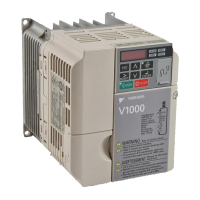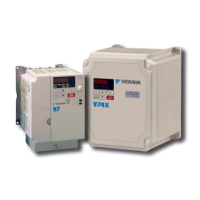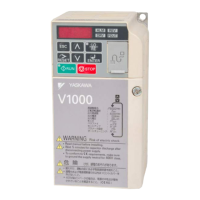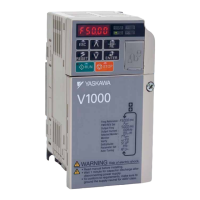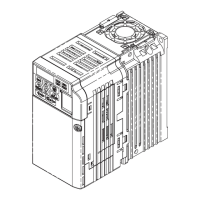5.3 Main Circuit Test Procedure
194 YASKAWA TM.V1000.01 V1000 Drive Installation & Start-Up Manual (Preliminary 01-19-07)
Output
Transistors
(Q1-Q6)
The output transistors are used to switch the DC bus voltage to allow current to flow to the
motor. The following checks will read erroneously if the DC bus fuse is open.
1. Set a digital multimeter to the Diode Check setting.
2. Place the positive (red) meter lead on terminal U/T1.
Place the negative (black) meter lead on terminal ⊕ 1. Expected reading is about 0.5 Vdc.
3. Place the positive (red) meter lead on terminal V/T2.
Place the negative (black) meter lead on terminal ⊕ 1. Expected reading is about 0.5 Vdc.
4. Place the positive (red) meter lead on terminal W/T3.
Place the negative (black) meter lead on terminal ⊕ 1. Expected reading is about 0.5 Vdc.
5. Place the positive (red) meter lead on terminal U/T1.
Place the negative (black) meter lead on terminal (-). Expected reading is OL displayed.
6. Place the positive (red) meter lead on terminal V/T2.
Place the negative (black) meter lead on terminal (-). Expected reading is OL displayed.
7. Place the positive (red) meter lead on terminal W/T3.
Place the negative (black) meter lead on terminal (-). Expected reading is OL displayed.
8. Place the positive (red) meter lead on terminal (-).
Place the negative (black) meter lead on terminal U/T1. Expected reading is about 0.5 Vdc.
9. Place the positive (red) meter lead on terminal (-).
Place the negative (black) meter lead on terminal V/T2. Expected reading is about 0.5 Vdc.
10. Place the positive (red) meter lead on terminal (-).
Place the negative (black) meter lead on terminal W/T3. Expected reading is about 0.5 Vdc.
11. Place the positive (red) meter lead on terminal ⊕ 1.
Place the negative (black) meter lead on terminal U/T1. Expected reading is OL displayed.
12. Place the positive (red) meter lead on terminal ⊕ 1.
Place the negative (black) meter lead on terminal V/T2. Expected reading is OL displayed.
13. Place the positive (red) meter lead on terminal ⊕1.
Place the negative (black) meter lead on terminal W/T3. Expected reading is OL displayed.
24 Vdc Cooling
Fans (Heatsink
& Internal)
The heatsink and internal cooling fans cool the heatsink as well as the output transistor modules
of the drive.
1. Conduct a visual inspection to ensure the fan turns freely.
2. Use a digital multimeter to check the fan if there is no physical evidence that the fan is
defective.
3. Set the digital multimeter to the R x 1 scale.
4. Measure across the fan motor terminals. If 0 Ω are measured, conclude that the fan motor is
shorted. If infinite Ω are measured, conclude that the fan motor is burned open.
5. If the fan is not working, then disconnect the fan and apply 24 Vdc to the fan to test the
motor.
230/240 Vac
Cooling Fans
(Heatsink)
The heatsink cooling fans cool the heatsink to remove heat from the drive.
1. Conduct a visual inspection to ensure the fan turns freely.
2. Use a digital multimeter to check the motor if there is no physical evidence that the fan is
defective.
3. Set a digital multimeter to the R x 1 scale.
4. Measure across the fan motor terminals. If the fan motor is good, the measured value should
be about 500 Ω. If 0 Ω are measured, conclude that the fan motor is shorted. If infinite Ω are
measured, conclude that the fan motor is burned open.
5. If the fan is not working, disconnect the fan and apply 230/240 Vac to the fan to test the
motor.
Check Procedure

